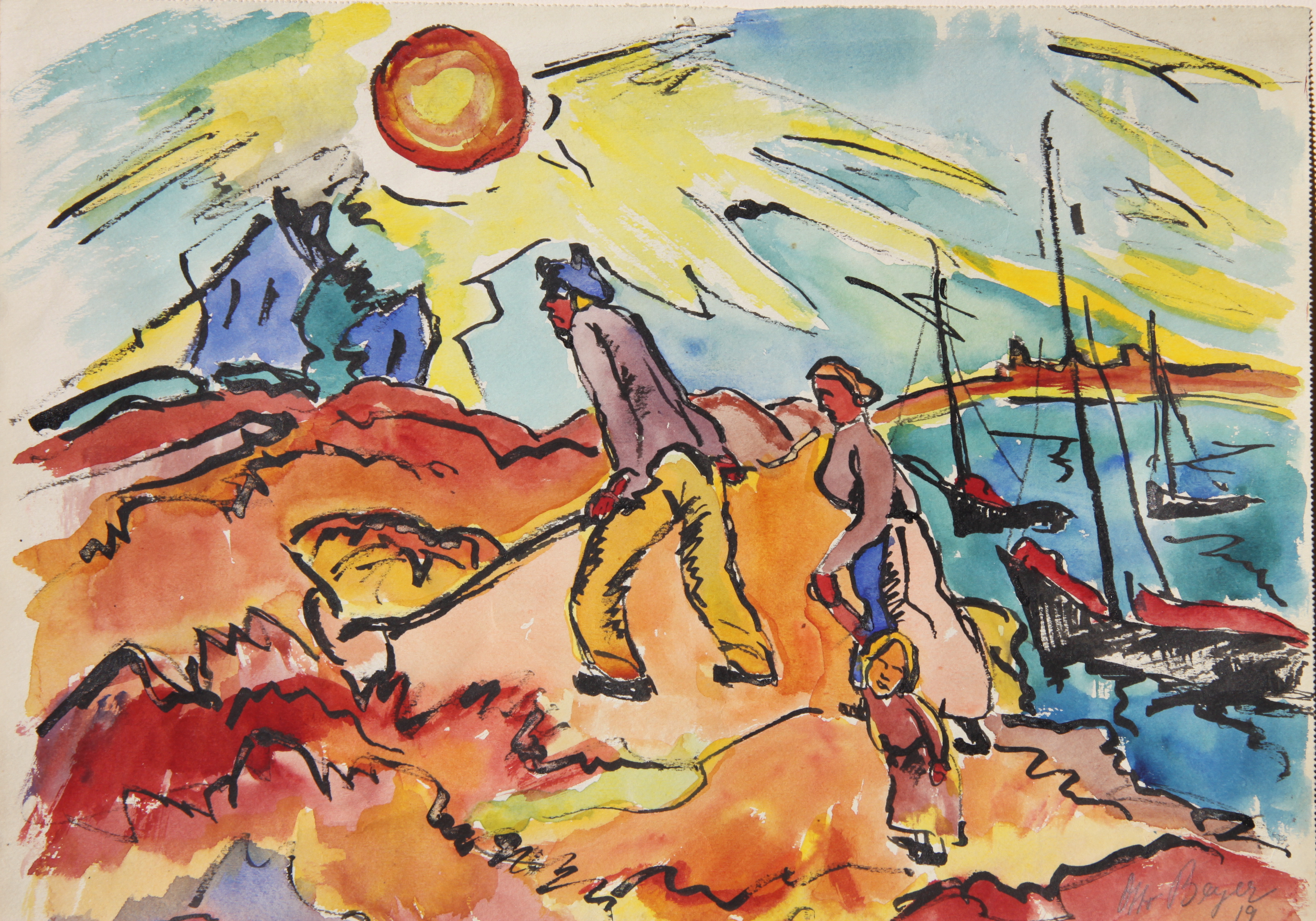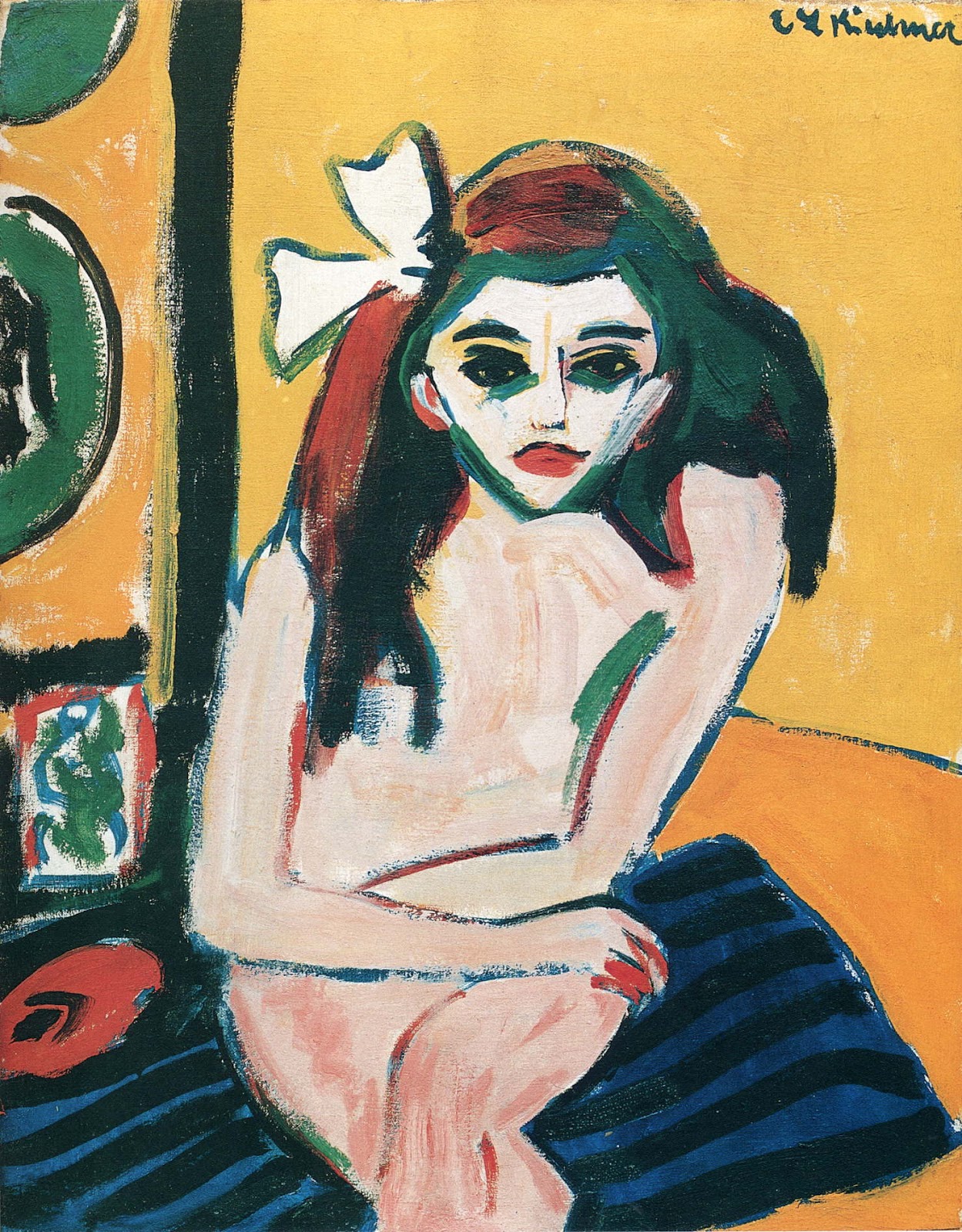|
Max Kaus
Max Kaus (11 March 1891 - 5 August 1977) was a German Expressionism, "second generation" expressionist Painting, painter and :de:Grafiker, graphic artist. He was also influential as a :de:Hochschullehrer, university level teacher and as deputy director at the Berlin University of the Arts, Academy for visual arts (''"Hochschule für Bildende Künste"'' / HfbK) in the city at that time known as West Berlin. Life Family provenance and early years Max Kaus was born and, eighty-six years later, died in Berlin. Joseph Kaus, his father, is described as "a church painter". His early training was in decorative art: between 1908 and 1913 he attended the :de:Unterrichtsanstalt des Kunstgewerbemuseums Berlin, Study Institute of the Decorative Arts Museum (''"Unterrichtsanstalt des Kunstgewerbemuseums"'' / UAKGM) in Berlin. He was powerfully influenced by the German Expressionism, expressionism of the movement known as Die Brücke, the Bridges Group (''"Die Brücke"''). His study wa ... [...More Info...] [...Related Items...] OR: [Wikipedia] [Google] [Baidu] |
Berlin
Berlin ( , ) is the capital and List of cities in Germany by population, largest city of Germany by both area and population. Its 3.7 million inhabitants make it the European Union's List of cities in the European Union by population within city limits, most populous city, according to population within city limits. One of Germany's States of Germany, sixteen constituent states, Berlin is surrounded by the Brandenburg, State of Brandenburg and contiguous with Potsdam, Brandenburg's capital. Berlin's urban area, which has a population of around 4.5 million, is the second most populous urban area in Germany after the Ruhr. The Berlin/Brandenburg Metropolitan Region, Berlin-Brandenburg capital region has around 6.2 million inhabitants and is Metropolitan regions in Germany, Germany's third-largest metropolitan region after the Rhine-Ruhr and Frankfurt Rhine-Main, Rhine-Main regions. Berlin straddles the banks of the Spree (river), Spree, which flows into the Havel (a tributary of ... [...More Info...] [...Related Items...] OR: [Wikipedia] [Google] [Baidu] |
Flanders
Flanders (, ; Dutch: ''Vlaanderen'' ) is the Flemish-speaking northern portion of Belgium and one of the communities, regions and language areas of Belgium. However, there are several overlapping definitions, including ones related to culture, language, politics, and history, and sometimes involving neighbouring countries. The demonym associated with Flanders is Fleming, while the corresponding adjective is Flemish. The official capital of Flanders is the City of Brussels, although the Brussels-Capital Region that includes it has an independent regional government. The powers of the government of Flanders consist, among others, of economic affairs in the Flemish Region and the community aspects of Flanders life in Brussels, such as Flemish culture and education. Geographically, Flanders is mainly flat, and has a small section of coast on the North Sea. It borders the French department of Nord to the south-west near the coast, the Dutch provinces of Zeeland, North Br ... [...More Info...] [...Related Items...] OR: [Wikipedia] [Google] [Baidu] |
Landscape Painting
Landscape painting, also known as landscape art, is the depiction of natural scenery such as mountains, valleys, trees, rivers, and forests, especially where the main subject is a wide view—with its elements arranged into a coherent composition. In other works, landscape backgrounds for figures can still form an important part of the work. Sky is almost always included in the view, and weather is often an element of the composition. Detailed landscapes as a distinct subject are not found in all artistic traditions, and develop when there is already a sophisticated tradition of representing other subjects. Two main traditions spring from Western painting and Chinese art, going back well over a thousand years in both cases. The recognition of a spiritual element in landscape art is present from its beginnings in East Asian art, drawing on Daoism and other philosophical traditions, but in the West only becomes explicit with Romanticism. Landscape views in art may be entir ... [...More Info...] [...Related Items...] OR: [Wikipedia] [Google] [Baidu] |
China Painting
China painting, or porcelain painting, is the decoration of glazed porcelain objects such as plates, bowls, vases or statues. The body of the object may be hard-paste porcelain, developed in China in the 7th or 8th century, or soft-paste porcelain (often bone china), developed in 18th-century Europe. The broader term ceramic painting includes painted decoration on lead-glazed earthenware such as creamware or tin-glazed pottery such as maiolica or faience. Typically the body is first fired in a kiln to convert it into a hard porous biscuit or bisque. Underglaze decoration may then be applied, followed by glaze, which is fired so it bonds to the body. The glazed porcelain may then be painted with overglaze decoration and fired again to bond the paint with the glaze. Most pieces use only one of underglaze or overglaze painting, the latter often being referred to as "enamelled". Decorations may be applied by brush or by stenciling, transfer printing, lithography and screen pr ... [...More Info...] [...Related Items...] OR: [Wikipedia] [Google] [Baidu] |
Free Secession
The Free Secession (german: Freie Secession) was an association of modern artists in Berlin organizing joint exhibitions 1914–1923. The Free Secession was formed after 42 members in late 1913 left the Berlin Secession, which thereby lost a majority of its members and nearly all of its most prominent artists. Max Liebermann Max Liebermann (20 July 1847 – 8 February 1935) was a German painter and printmaker, and one of the leading proponents of Impressionism in Germany and continental Europe. In addition to his activity as an artist, he also assembled an important ..., a former co-founder and leader of the Berlin Secession was made honorary president of the Free Secession. Notable members References Schubert, DietrichAnmerkungen zur ersten Ausstellung der Freien Secession in Berlin, April 1914.In: ''Jahrbuch der Berliner Museen'' (2010). Retrieved 14 January 2016. [...More Info...] [...Related Items...] OR: [Wikipedia] [Google] [Baidu] |
Otto Müller (painter)
Otto Müller (November 21, 1898 – December 9, 1979) was a German painter and graphic designer. Life and work Parental home Müller was born on November 21, 1898, in Cröllwitz, which since 1900 was a part of the city of Halle, Saxony-Anhalt. He was the first child of the engine driver Karl Christoph Friedrich Otto Müller (1874–1951) and Anna Müller, née Schmidt (1876–1923). He had one brother and two sisters. Education Müller went to school in Halle for eight years. He went to train as a Lithography, lithographer from 1913 to 1917. During this period, he also attended evening classes in drawing and painting at the Staatliche Städtische Handwerkerschule, later known as the Kunstgewerbeschule Burg Giebichenstein (Burg Giebichstein Academy of Arts and Crafts), in Halle. During the World War I, First World War in 1918, Müller was called up to serve on the Western Front in France. After being demobilised in 1919, he started studying painting at the Burg Gieb ... [...More Info...] [...Related Items...] OR: [Wikipedia] [Google] [Baidu] |
Ferdinand Möller
Ferdinand Möller (15 October 1882 - 12 January 1956) was one of Adolf Hitler, Hitler's Nazi art dealers specialized in selling looted "Degenerate art". A high-profile Germany, German art dealer and gallery owner, Möller's career was at its height through the Weimar Republic, years of the German Republic. After Machtergreifung, 1933, being neither Jewish nor among those identified by Nazi Party, the party as Anti-fascism, a government opponent, he remained a leading figure in the German arts world, although the nature of the arts business was transformed during the Nazi Germany, Hitler years: in or soon after 1937 Möller was obliged to end his involvement with organising art exhibitions. He remained active as an art dealer of traditional and modern works throughout his life. In 1938 Möller became one of four leading art dealers mandated to dispose of art works confiscated in the context of the government's campaign against so-called degenerate art. Many sources assert or imply ... [...More Info...] [...Related Items...] OR: [Wikipedia] [Google] [Baidu] |
Karl Schmidt-Rottluff
Karl Schmidt-Rottluff (Karl Schmidt until 1905; 1 December 1884 – 10 August 1976) was a German expressionist painter and printmaker; he was one of the four founders of the artist group Die Brücke. Life and work Schmidt-Rottluff was born in Rottluff, nowadays a district of Chemnitz, on 1 December 1884. He attended the ''humanistische gymnasium'' (classics-oriented secondary school) in Chemnitz, where he befriended Erich Heckel. He enrolled in architecture at the Sächsische Technische Hochschule in Dresden in 1905, following in Heckel's footsteps, but gave up after one term. Whilst he was there, however, Erich Heckel introduced him to Ernst Ludwig Kirchner and Fritz Bleyl. They all passionately shared similar artistic interests and used architecture as a front to study art. They founded Die Brücke in Dresden on 7 June 1905, with the aim of creating a style that was uncompromising and which renounced all traditions. Its first exhibition opened in Leipzig in November of the sa ... [...More Info...] [...Related Items...] OR: [Wikipedia] [Google] [Baidu] |
Ernst Ludwig Kirchner
Ernst Ludwig Kirchner (6 May 1880 – 15 June 1938) was a German expressionist painter and printmaker and one of the founders of the artists group Die Brücke or "The Bridge", a key group leading to the foundation of Expressionism in 20th-century art. He volunteered for army service in the First World War, but soon suffered a breakdown and was discharged. His work was branded as "degenerate" by the Nazis in 1933, and in 1937 more than 600 of his works were sold or destroyed."Ernst Ludwig Kirchner: German, 1880–1938" . |
Lithographic Limestone
Lithographic limestone is hard limestone that is sufficiently fine-grained, homogeneous and defect free to be used for lithography. Geologists use the term "lithographic texture" to refer to a grain size under 1/250 mm. The term "sublithographic" is sometimes used for homogeneous fine-grained limestone with a somewhat coarser texture. Origin The generally accepted theory for the origin of lithographic and sublithographic limestones is that they were formed in shallow, stagnant, hypersaline, and anoxic lagoons. The combination of mild hypersalinity and low oxygen content is believed to have inhibited the formation of microbial mats and prevented the invasion of bottom dwelling organisms. Microbial mats and bottom dwelling organisms would have left fossils, and bottom dwelling organisms would have churned the accumulating sediment, producing a less homogeneous rock. Stagnancy was required to avoid churning or sculpting of the sediment by currents or wave action.Walter ... [...More Info...] [...Related Items...] OR: [Wikipedia] [Google] [Baidu] |
Oostende Railway Station
Oostende railway station ( nl, Station Oostende, french: Gare d'Ostende, List of IATA-indexed railway stations, IATA code: ZGJ), officially Oostende, is a railway station in Ostend, West Flanders, Belgium. It is operated by the National Railway Company of Belgium (NMBS/SNCB). History The first station in Ostend was opened in 1838 during the reign of Leopold I of Belgium, King Leopold I on the former Belgian railway line 62 to Torhout and is now a supermarket. The current station was opened in 1913 during the reign of Albert I of Belgium, King Albert I. It is designed to connect trains and ferries and is built with Scotland, Scottish granite, bluestone from Soignies and limestone from Euville. It is constructed in a Neoclassical architecture, neoclassical style inspired by the French 18th-century architect François Mansart and the Louis XVI style. The station was served by a daily Thalys high-speed rail service to Gare du Nord, Paris between 1998 and 31 March 2015. Train servi ... [...More Info...] [...Related Items...] OR: [Wikipedia] [Google] [Baidu] |







